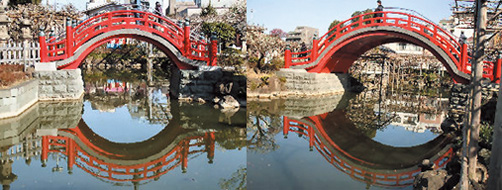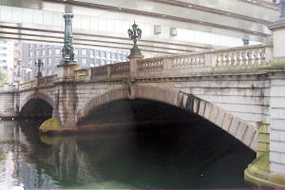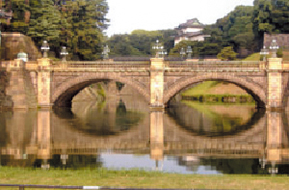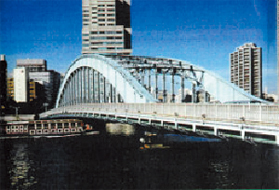| 1. |
Concrete Arch Bridge |
Kameido Tenjin Bridge |
 |
 Onna Bashi (Women bridge) Onna Bashi (Women bridge) |
 Otoko Bashi (Men bridge) Otoko Bashi (Men bridge) |
You can see the two large and small arched bridges in the precincts of
Kameido shrine, Koto ward. They are each called Otoko-Bashi, Onna-Bashi,
from the right. Otoko-bashi stands for a mountain of hardship in the past
and Onna-Bashi stands for future. The shrine says that crossing these bridges,
you can arrived in front of a god. Before they were vermilion-lacquered
bridges, but they were damaged by a war and re-constructed as a concrete
arch bridge in 1952.
The shrine is called as Kameido Tenmangu, which stands for a shrine dedicated
to Sugawara no Michizane, the patron saint of scholarship, and famous as
a grand shrine in the Edo period as well as Fukagawa Hachimangu. They are
erected in imitation of Dazaifu Tenmangu of Kyushu in the eras of Tsunayoshi's
Bakufu, and the time of Sugawara no Michizane as an enshrined deity: it
must be a tutelary deity for a newly developed land. Also the precincts
of Kameido shrine are known for a noted place of 80 roots of wisteria,
which are drawn in a print at that time; it is used in the cover page of
the 100 bridges.
| 2. |
Stone-Built Arch Bridge |
Nihon-Bashi |
As locating the Edo-Bakufu, Tokugawa Ieyasu built the bridge to link with
the new city, which are made by reclaiming the part of sea in 1603. You
could say that Town creation of Tokyo started from construction of the
Nihon-bashi.
Next year, the five main highways such as Tokaido were defined starting from here. Current Nihon-Bashi is a stone-built arch erected in 1911. It is designated as an important cultural property, marked a milestone and a ornamental top of a railing. You could say that its design is the most important work of a combination of Japanese, Chinese and European styles. Its bridge name was called Nihon-Bashi after the Nihon-Bashi river.
Because a highway was built directly above the bridge in 1964, there has been a lot of controversy about bridge landscape; it should be removed or moved. People are searching re-construction plans. There are some plan that it should imitate the Cheonggyecheon, Seoul, South Korea, which is a good case that Lee Myung-bak, Seoul mayor then re-established a stream and landscape by removing the elevated highway and restoring the stream.
| 3. |
Steel Arch Bridge |
Nijuu-Bashi |
The photo shows a steel bridge crossing the imperial moat, and there are
stone-built bridges at the back; a stone-built bridge is called "Nishinomaru
Ote-Bashi" and a steel bridge is called "Nishinomaru Shimojo-Bashi"
Nijuu-Bashi, which is crossed over deep moats and the girder supporting
piers, is called after a double structural crossing technique.
It was a wood structural arch bridge(Total Length: 29m, Width: 6.5m) in the Edo period, but was replaced with a steel bridge made in Germany in 1888, by asking a Germany company to do that.
After that, they are reborn in 1964. Though the Imperial Household Agency calls the stone-built bridge for "Seimon Ishibashi", the steel bridge for "Seimon Tetsubashi", in general they are collectively called "Nijui-Bashi"
| 4. |
Steel Arch Bridge |
Eidai-Bashi |
Eidai-Bashi was crossed by Tokugawa-Bakufu in 1698; it was fourth bridge
crossed in Suminda River, following Ryogoku-Bashi, Shin-Ohashi, and Azuma-Bashi.
The size of the wooden bridge at that time was 200m × 6m.
In 1698 during the Fukagawa-Tomioka Hachiman Festival, terrible catastrophe
happened, which was caused by weight limit over. The bridge fell
down because quite a lot of viewers gathered in the one place. The people
in charge were punished with banishment to a distant island.
In 1897 it was replaced with a steel bridge, above 200m away from the
original. The finished bride was huge construction with the size of 200m
x 14m, which attracted people's attention; it cost as much as 83,650 yen
and took three and half years for construction.
After that it was replaced in 1926. Compared with Kiyoshu-Bashi, it looks more masculine and has heavier weight. It has been read as "Eidaiha doshinto oita youni kake" meaning "Eidai-Bashi was crossed as if it was with a solid appearance" in Senryu.
 |
•Hijiri-Bashi
Concrete Arch Bridge
Total Length: 92.47m
Width: 22m
Named after the thing the connecting between Yushima Seido and Holy Resurrection
Cathedral. |
|
 |
•Yahata-Bashi
Bowstrings Truss Built Bridge
Total Length: 15.76m
Width: 2.0m
The oldest steel bridge in Japan, designated as national important
cultural properties.
Built in 1879 |
 |
•Shin Kasai-Bashi
Cantilever Bridge with its Stiffening Girder Suspended
Total Length: 280m
Width: 15m
Self-Anchored Suspension Bridge,the worild's first unique type bridge, which look like Kiyosu-Bashi. |
|
 |
•Haneda Sky Arch
Parallel Cable-Stayed Bridge with Arch Type Main Tower
Total Length: 103.40m
Width:10.25m
Won the Tanaka Award by Japan Society of Civil Engineering |
 |
•Rainbow Bridge
Bi-layer Suspension Bridge
Total Length: 918m
Width: 70m
Highway, roadway, footway, Waterfront Area Rapid Transit |
|
 |
•Otonashi-Bashi
Concrete-Built Three Consecutive Arch Bridge
Total Length: approximate 497m
Width of roadway: approximate 194m
Width of footway: approximate 303m
Old bridge built in 1930 |
 |
•Tamagawa-Ohashi
Gerber Plate Girder Bridge
Total Length: 435.76m
Width: 22.8m
The first bridge with a mercury lamp in Japan |
|













